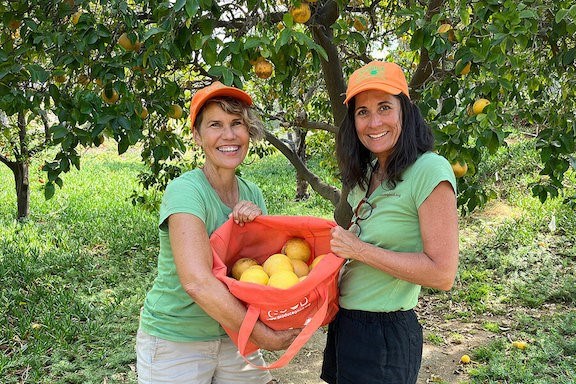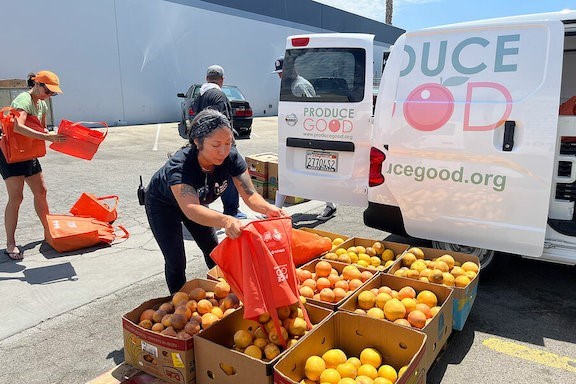 Nita Kurmins Gilson (left) and Alexandra White, co-executive directors of the gleaning nonprofit ProduceGood, show a sample of the morning's efforts at the property of John and Carolyn Melka in Bonsall, California, July 27, 2022. Ms. Kurmins Gilson and Ms. White want to spread "the gospel of glean" as a way to simultaneously tackle excess food and hunger. Francine Kiefer/The Christian Science Monitor
Nita Kurmins Gilson (left) and Alexandra White, co-executive directors of the gleaning nonprofit ProduceGood, show a sample of the morning's efforts at the property of John and Carolyn Melka in Bonsall, California, July 27, 2022. Ms. Kurmins Gilson and Ms. White want to spread "the gospel of glean" as a way to simultaneously tackle excess food and hunger. Francine Kiefer/The Christian Science Monitor
A drive through hills and vineyards of northern San Diego County leads to a community built especially for equestrians. Paddocks dot the generously sized lots and so do citrus trees, lots of them, with ripe grapefruit waiting to be picked and no one to harvest them.
That’s what brings a small band of volunteer gleaners to the home of John and Carolyn Melka, who have more than 90 grapefruit trees on their hillside property. At the top of their driveway, Nita Kurmins Gilson is giving a brief tutorial to the volunteers, starting with an explanation of gleaning. “Most people ... think we’re saying ‘cleaning,’” she says. But the word refers to the ancient practice of farmers leaving the four corners of their fields unpicked for widows and orphans – the most famous gleaner being the biblical widow Ruth.
Gathering excess and distributing it to those in need, that’s the purpose of ProduceGood, the nonprofit led by Ms. Kurmins Gilson and co-Executive Director Alexandra White. On this morning, the efforts of their four volunteers – two retired teachers and two college students – will multiply into 700 pounds of grapefruit that will help feed people experiencing food insecurity at a nearby charity. The volunteers are part of ProduceGood’s vast network of cooperation that relies on thousands of volunteers helping hundreds of local growers get fresh fruit to food relief agencies throughout San Diego County. Ms. White estimates that ProduceGood feeds about 90,000 people a year
 Francine Kiefer/The Christian Science MonitorMonica Reyes, food-rescue manager for the Brother Benno Foundation in Oceanside, California, unloads grapefruits July 27, 2022, from that morning's gleaning by volunteers for ProduceGood. "There's a really big need for fresh produce" to help feed low-income and unhoused people, she says.
Francine Kiefer/The Christian Science MonitorMonica Reyes, food-rescue manager for the Brother Benno Foundation in Oceanside, California, unloads grapefruits July 27, 2022, from that morning's gleaning by volunteers for ProduceGood. "There's a really big need for fresh produce" to help feed low-income and unhoused people, she says.
“We’re trying to reduce food waste and hunger at the same time while building community,” says Ms. Kurmins Gilson – pointing out that as much as 40% of all food in America is wasted, while nutrition insecurity in San Diego County increased from 1 in 4 to 1 in 3 people during the pandemic. She underscores the unity of purpose and cooperation among all the many people and organizations involved. “We could never do this by ourselves.”
Though data is hard to nail down because of the grassroots nature of gleaning, it’s “definitely on the rise” in the United States, says Laurie Beyranevand, director of the Center for Agriculture and Food Systems at Vermont Law and Graduate School in South Royalton, Vermont. “With all the increased attention by government on food-and-nutrition insecurity and food waste, people have become increasingly interested in gleaning as a way to resolve this issue.” A bonus is that it “builds community,” she says, connecting residents with farmers and turning volunteerism into a recreational activity. The Association of Gleaning Organizations counts more than 200 groups doing this work in the U.S.
Like the ubiquitous citrus trees of San Diego County, ProduceGood started from a seed. Ms. Kurmins Gilson recalls her teenage daughter despairing over dismal statistics about the environment. Her daughter was only 14 and had already given up on the world, but this mother was not ready to abandon hope. She impressed upon her daughter that one person, taking one step, could make a difference.
Ms. Kurmins Gilson, who had long been disturbed by fruit rotting on the ground wherever she looked, took that first step in 2009. She went to the local grocery store, picked up boxes on a Friday night, gleaned with friends in someone’s yard the next morning, and then drove the fruit to a food bank before it closed at noon. The casual gleaning turned into something much bigger, and in 2014, she and a mother-daughter team – Jeri and Alex White – created the 501(c)(3), ProduceGood. Now they could get grants. “From that point, it’s been like a rocket ship,” she says.
The pandemic proved pivotal. With restaurants and workplaces shuttered, farmers had no place to take their produce. At the same time, people were home, looking for things to do and ways to be outdoors. Meanwhile, food insecurity escalated. ProduceGood responded, filling a point-to-point need of getting fresh produce directly to people who needed it – including a pop-up food table in a heavily hit neighborhood in San Diego.
Related stories
-
Drinking water in short supply? There’s a solution in the air.
-
THE EXPLAINER Don’t pitch those peels, recycle them: California’s new food-waste law
-
Wings and a prayer: Monarch surge brings hope for butterfly recovery
-
THE EXPLAINER Clean energy depends on lithium. Can California supply it?







